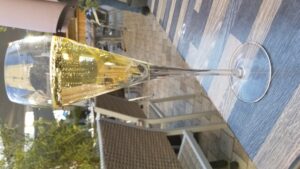Sparkling wine is made almost everywhere that grapes are grown. We’ve had sparklers from France (Champagne, the Loire), Napa Valley, Sonoma County, South Africa, Australia, Long Island and Brazil (yes, Brazil). But only the sparkling wines of the Champagne region in northern France can be called Champagne. Real Champagne can only be made from three grapes, one of which is white (Chardonnay) and two reds (Pinot Noir and Pinot Meunier). Any sparkling wine that has pretentions of real Champagne must be made by the méthode champenoise, with still white wine double fermented in the bottle.
So when you’re looking to buy a bottle of bubbles, which one should you choose?
- Why are you buying it? If it’s to drink by the pool on a hot summer afternoon, there’s no sense spending big money for a great wine. There are many California sparkling wines that are affordable and quite good, Domaine Chandon and Domaine Carneros being the best known. On the other hand, if the purchase is for a romantic dinner or a big celebration, go for the real stuff. It will cost you more; it’s hard these days to find any Champagne for less than $40, but that’s what romance and celebrations cost.
- Where are you? If you’re in Italy, drink Prosecco. In Spain, order the Cava. In Germany, it’s Sekt. In other words, do what the locals do. Note that in California and Long Island, the people there do drink imported Champagne as well as the local sparkling wines.
- How much do you want to spend? As mentioned, real Champagne doesn’t come cheap. But there are also many American sparklers that are fairly expensive. For example, a bottle of Domaine Carneros Le Rêve can set you back up to $125. And, without mentioning names, there are some wines with bubbles in them that are very cheap but aren’t even worth the ten bucks or less that you’ll pay for them. So be reasonable, set your price point and then buy accordingly.
- Have you tried them? Just because a wine comes from Champagne doesn’t guarantee that you’ll like it. We like most that we’ve had, but there are some that just don’t tickle our palates as much as, say, a Sparkling Pointe from Long Island. Wine tasting rule #1 is know what you like: If there’s a sparkling wine you particularly like, by all means buy it. If your intent is to impress your friends with your wine expertise (never a very good idea), you’d better try it first. There are gems at relatively low prices and there are expensive Champagnes that, to our tastes, just aren’t worth the expense. Sometimes it’s a good idea to experiment, just to find out which is which.
- Do you remember what it’s called? That’s wine tasting rule #2. If, say, you were at a party and the host poured you a glass of something that knocked your socks off, ask what it is so you can buy it yourself. If you’re not good at remembering names, write it down. A name like Tribaut Schlosser doesn’t exactly roll off the tongue and there’s a good chance you wouldn’t be able to pronounce it to the store clerk from memory alone. (By the way, it’s Tree-boe Shlahs-er.)
